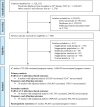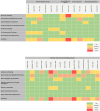Effectiveness and safety of COVID-19 vaccines on maternal and perinatal outcomes: a systematic review and meta-analysis
- PMID: 38580375
- PMCID: PMC11002410
- DOI: 10.1136/bmjgh-2023-014247
Effectiveness and safety of COVID-19 vaccines on maternal and perinatal outcomes: a systematic review and meta-analysis
Abstract
Objective: To assess the effects of COVID-19 vaccines in women before or during pregnancy on SARS-CoV-2 infection-related, pregnancy, offspring and reactogenicity outcomes.
Design: Systematic review and meta-analysis.
Data sources: Major databases between December 2019 and January 2023.
Study selection: Nine pairs of reviewers contributed to study selection. We included test-negative designs, comparative cohorts and randomised trials on effects of COVID-19 vaccines on infection-related and pregnancy outcomes. Non-comparative cohort studies reporting reactogenicity outcomes were also included.
Quality assessment, data extraction and analysis: Two reviewers independently assessed study quality and extracted data. We undertook random-effects meta-analysis and reported findings as HRs, risk ratios (RRs), ORs or rates with 95% CIs.
Results: Sixty-seven studies (1 813 947 women) were included. Overall, in test-negative design studies, pregnant women fully vaccinated with any COVID-19 vaccine had 61% reduced odds of SARS-CoV-2 infection during pregnancy (OR 0.39, 95% CI 0.21 to 0.75; 4 studies, 23 927 women; I2=87.2%) and 94% reduced odds of hospital admission (OR 0.06, 95% CI 0.01 to 0.71; 2 studies, 868 women; I2=92%). In adjusted cohort studies, the risk of hypertensive disorders in pregnancy was reduced by 12% (RR 0.88, 95% CI 0.82 to 0.92; 2 studies; 115 085 women), while caesarean section was reduced by 9% (OR 0.91, 95% CI 0.85 to 0.98; 6 studies; 30 192 women). We observed an 8% reduction in the risk of neonatal intensive care unit admission (RR 0.92, 95% CI 0.87 to 0.97; 2 studies; 54 569 women) in babies born to vaccinated versus not vaccinated women. In general, vaccination during pregnancy was not associated with increased risk of adverse pregnancy or perinatal outcomes. Pain at the injection site was the most common side effect reported (77%, 95% CI 52% to 94%; 11 studies; 27 195 women).
Conclusion: COVID-19 vaccines are effective in preventing SARS-CoV-2 infection and related complications in pregnant women.
Prospero registration number: CRD42020178076.
Keywords: COVID-19; obstetrics; vaccines.
© World Health Organization 2024. Licensee BMJ.
Conflict of interest statement
Competing interests: None declared.
Figures



References
-
- World Health Organization . COVID-19 vaccines technical documents. n.d. Available: https://www.who.int/groups/strategic-advisory-group-of-experts-on-immuni...
-
- World Health Organization . SAGE updates COVID-19 vaccination guidance. 2023. Available: https://www.who.int/news/item/28-03-2023-sage-updates-covid-19-vaccinati...
Publication types
MeSH terms
Substances
Grants and funding
LinkOut - more resources
Full Text Sources
Medical
Miscellaneous
